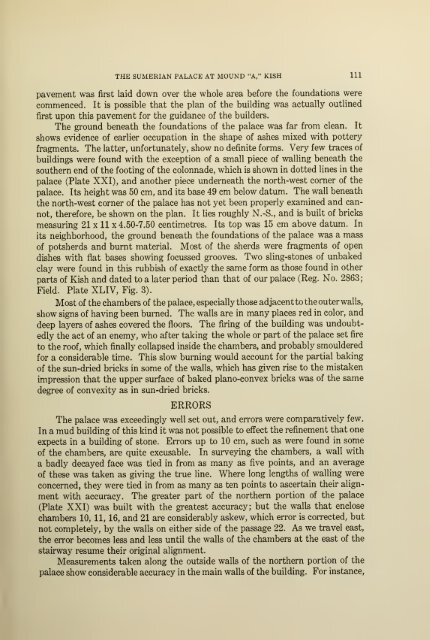A Sumerian Palace and the "A" cemetery at Kish, Mesopotamia
A Sumerian Palace and the "A" cemetery at Kish, Mesopotamia
A Sumerian Palace and the "A" cemetery at Kish, Mesopotamia
Create successful ePaper yourself
Turn your PDF publications into a flip-book with our unique Google optimized e-Paper software.
THE SUMERIAN PALACE AT MOUND "A," KISH 111<br />
pavement was first laid down over <strong>the</strong> whole area before <strong>the</strong> found<strong>at</strong>ions were<br />
commenced. It is possible th<strong>at</strong> <strong>the</strong> plan of <strong>the</strong> building was actually outlined<br />
first upon this pavement for <strong>the</strong> guidance of <strong>the</strong> builders.<br />
The ground bene<strong>at</strong>h <strong>the</strong> found<strong>at</strong>ions of <strong>the</strong> palace was far from clean. It<br />
shows evidence of earlier occup<strong>at</strong>ion in <strong>the</strong> shape of ashes mixed with pottery<br />
fragments. The l<strong>at</strong>ter, unfortun<strong>at</strong>ely, show no definite forms. Very few traces of<br />
buildings were found with <strong>the</strong> exception of a small piece of walling bene<strong>at</strong>h <strong>the</strong><br />
sou<strong>the</strong>rn end of <strong>the</strong> footing of <strong>the</strong> colonnade, which is shown in dotted lines in <strong>the</strong><br />
palace (Pl<strong>at</strong>e XXI), <strong>and</strong> ano<strong>the</strong>r piece underne<strong>at</strong>h <strong>the</strong> north-west corner of <strong>the</strong><br />
palace. Its height was 50 cm, <strong>and</strong> its base 49 cm below d<strong>at</strong>um. The wall bene<strong>at</strong>h<br />
<strong>the</strong> north-west corner of <strong>the</strong> palace has not yet been properly examined <strong>and</strong> can-<br />
not, <strong>the</strong>refore, be shown on <strong>the</strong> plan. It lies roughly N.-S., <strong>and</strong> is built of bricks<br />
measuring 21 x 11 x 4.50-7.50 centimetres. Its top was 15 cm above d<strong>at</strong>um. In<br />
its neighborhood, <strong>the</strong> ground bene<strong>at</strong>h <strong>the</strong> found<strong>at</strong>ions of <strong>the</strong> palace was a mass<br />
of potsherds <strong>and</strong> burnt m<strong>at</strong>erial. Most of <strong>the</strong> sherds were fragments of open<br />
dishes with fl<strong>at</strong> bases showing focussed grooves. Two sling-stones of unbaked<br />
clay were found in this rubbish of exactly <strong>the</strong> same form as those found in o<strong>the</strong>r<br />
parts of <strong>Kish</strong> <strong>and</strong> d<strong>at</strong>ed to a l<strong>at</strong>er period than th<strong>at</strong> of our palace (Reg. No. 2863;<br />
Field. Pl<strong>at</strong>e XLIV, Fig. 3).<br />
Most of <strong>the</strong> chambers of <strong>the</strong> palace, especially those adjacent to <strong>the</strong> outer walls,<br />
show signs of having been bui-ned. The walls are in many places red in color, <strong>and</strong><br />
deep layers of ashes covered <strong>the</strong> floors. The firing of <strong>the</strong> building was undoubt-<br />
edly <strong>the</strong> act of an enemy, who after taking <strong>the</strong> whole or part of <strong>the</strong> palace set fire<br />
to <strong>the</strong> roof, which finally collapsed inside <strong>the</strong> chambers, <strong>and</strong> probably smouldered<br />
for a considerable time. This slow burning would account for <strong>the</strong> partial baking<br />
of <strong>the</strong> sun-dried bricks in some of <strong>the</strong> walls, which has given rise to <strong>the</strong> mistaken<br />
impression th<strong>at</strong> <strong>the</strong> upper surface of baked plano-convex bricks was of <strong>the</strong> same<br />
degree of convexity as in sun-dried bricks.<br />
ERRORS<br />
The palace was exceedingly well set out, <strong>and</strong> errors were compar<strong>at</strong>ively few.<br />
In a mud building of this kind it was not possible to effect <strong>the</strong> refinement th<strong>at</strong> one<br />
expects in a building of stone. Errors up to 10 cm, such as were found in some<br />
of <strong>the</strong> chambers, are quite excusable. In surveying <strong>the</strong> chambers, a wall with<br />
a badly decayed face was tied in from as many as five points, <strong>and</strong> an average<br />
of <strong>the</strong>se was taken as giving <strong>the</strong> true line. Where long lengths of walling were<br />
concerned, <strong>the</strong>y were tied in from as many as ten points to ascertain <strong>the</strong>ir alignment<br />
with accm-acy. The gre<strong>at</strong>er part of <strong>the</strong> nor<strong>the</strong>rn portion of <strong>the</strong> palace<br />
(Pl<strong>at</strong>e XXI) was built with <strong>the</strong> gre<strong>at</strong>est accuracy; but <strong>the</strong> walls th<strong>at</strong> enclose<br />
chambers 10, 11, 16, <strong>and</strong> 21 are considerably askew, which error is corrected, but<br />
not completely, by <strong>the</strong> walls on ei<strong>the</strong>r side of <strong>the</strong> passage 22. As we travel east,<br />
<strong>the</strong> error becomes less <strong>and</strong> less until <strong>the</strong> walls of <strong>the</strong> chambers <strong>at</strong> <strong>the</strong> east of <strong>the</strong><br />
stairway resume <strong>the</strong>ir original alignment.<br />
Measurements taken along <strong>the</strong> outside walls of <strong>the</strong> nor<strong>the</strong>rn portion of <strong>the</strong><br />
palace show considerable accuracy in <strong>the</strong> main walls of <strong>the</strong> building. For instance.

















